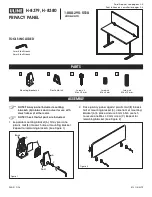
9
5.0 Inspection and
Maintenance
5.1 Inspection and Operation
Testing
Honeywell’s inspection requirements incorporate
the criteria established by current safety
standards. The inspection criteria for the
equipment shall be set by the user’s organization,
such that it equals or exceeds the criteria
required by the manufacturer and the standards
with which the organization elects to comply.
Equipment shall be thoroughly inspected
and operationally tested by the user before
each use, and additionally, by a competent
person, other than the user, at least annually
(or semi-annually per ANSI A10.32) for:
[*ANSI Z359.14 and CSA Z259.2.2-17 provide
additional inspection requirements based on type
of use and conditions of use. Refer to Table 2 for
compliance with these standards. (*See note in 6.2
Maintenance.)]
Absence or illegibility of markings/labels.
Absence of any elements affecting the
equipment form, fit or function.
Evidence of defects in or damage to the
cable lifeline including cuts, broken strands,
corrosion, kinks, chemical attack, abrasion,
alteration, excessive aging, and excessive wear.
CAUTION:
Always wear gloves when
inspecting cable lifelines; broken strands
can cause injury!
Operational damage to the lifeline.
Retraction
- With the device in a mounted
position, test the lifeline retraction and tension
by
pulling out several feet of the lifeline and allow
to retract back into the unit. Always maintain
a light tension on the lifeline as it retracts. The
lifeline should pull out freely and retract all the
way back into the unit. If the lifeline does not
pull out smoothly or sticks when retracting, pull
all the lifeline out of the housing and allow it to
retract slowly under tension. Do not use the unit
if the lifeline does not retract properly.
CAUTION:
Do not let go of the lifeline and
let it retract on its own; always maintain
tension while it retracts!
Lockup Mechanism
-
The braking mechanism
can be tested by grasping the lifeline and
applying a sharp steady pull downward which
will engage the brakes. There should be no
slippage of the lifeline while the brakes are
engaged. Once tension is released, the brakes
will disengage and the unit will return to the
retractable mode.
Evidence of defects in or damage to
hardware elements including cracks, breaks,
rough or sharp edges, deformation, corrosion,
chemical attack, excessive heating, pitted
surfaces, alteration, and excessive wear.
Type of
Use
Application
Examples
Conditions of Use
Worker
Inspection
Frequency
Competent
Person
Inspection
Frequency
APPLIES TO CSA
ONLY
Product Revalida
-
tion Frequency
Infrequent
to Light
Rescue & con
-
fined space,
factory
maintenance
Good storage conditions,
indoor or infrequent outdoor
use, room temperature,
clean environments
Before each
use
Annually
At least every 5
years but not more
than intervals
required by the
manufacturer
Moderate
to Heavy
Transportation,
residential
construction,
utilities, ware
-
house
Fair storage conditions, in
-
door and extended outdoor
use, all temperatures, clean
or dusty environments
Before each
use
Semi-
annually to
annually
At least every 2
years but not more
than intervals
required by the
manufacturer
Severe to
Continuous
Commercial
construction,
oil & gas,
mining
Harsh storage conditions,
prolonged or continuous out-
door use, all temperatures,
dirty environment
Before each
use
Quarterly
to semi-
annually
At least annually
but not more than
intervals required by
the manufacturer
Notes:
1) Failure of a worker to perform “before each use” inspection or failure of an inspection by a worker shall
initiate the requirement for inspection by a competent person.
2) Failure of a competent person to perform inspections as specified in this Table, or failure of an inspection by
the competent person shall initiate product revalidation or disposal.
3) Determination of the type of use category shall be determined by a competent person.
4) A SRD that is considered non-repairable, or not designed for disassembly such that internal inspection is not
possible without rendering it unserviceable, is not subject to revalidation inspection. These SRD’s shall have
service life and other inspection requirements as provided by the manufacturer’s instructions.
TABLE 2: ANSI Z359.14 and CSA Z259.2.2-17: Inspection Requirements










































